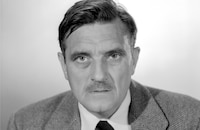Rocketship X-M
Brief Synopsis
Cast & Crew
Lloyd Bridges
Osa Massen
John Emery
Noah Beery Jr.
Hugh O'brian
Morris Ankrum
Film Details
Technical Specs

Synopsis
At the government testing grounds at White Sands, New Mexico, research scientist Dr. Fleming holds a press conference to announce the imminent launch of the first manned spaceship, the R X-M, or Rocketship Expedition Moon. He introduces the crew: Dr. Karl Eckstrom, designer of the space craft; chemist Dr. Lisa Van Horn; pilot Col. Floyd Graham; astronomer Harry Chamberlin, who will serve as navigator; and engineer Major William Corrigan. Karl presents the flight plan and explains they plan to reach the moon in forty-eight hours. After the rocketship is launched, the crew members marvel at the sight of planet Earth as they leave its orbit. Fourteen hours into the flight, however, the ship loses power, and Karl insists on altering the fuel mixture. Later, as the rest of the crew sleeps, Floyd tries to interest Lisa in romance, but a sudden meteor shower breaks the mood. After some mechanical adjustments, the new fuel ratio is tested and the ship accelerates rapidly, moving completely off course. Karl is astonished to discover that the ship is approaching Mars. After landing, the crew members leave the ship and begin to investigate the arid planet and its colorful rock formations. They come across part of a metal statue covered in sand, suggesting the presence of man on the planet at one time, and their instruments detect high levels of radioactivity. After commenting on man's tendency toward self-destruction, Karl concludes that the planet's entire population was wiped out in an atomic blast. While the others are asleep, however, Harry sees a group of men emerge from the rocks. Karl and William set out to investigate, and they soon discover a mutant race of humans, apparently the survivors of the atomic blast that devastated the planet. The creatures attack them with rocks, and William is killed. Badly injured, Karl makes it back to the ship and after telling his crewmates to report what they have seen, collapses and dies. The mutants then attack the remaining crew members, but Floyd and Lisa escape to the rocketship with the injured Harry and leave Mars. On the ship, Lisa discovers that they do not have enough fuel for a landing. Determined to see that their tragic mission was not in vain, Floyd and Lisa contact Dr. Fleming on the radio and tell him what has happened. As they plummet to their death, Floyd and Lisa embrace. Later, Dr. Fleming meets with reporters and maintains that the expedition was not a failure, and that construction of the next rocketship will begin tomorrow.

Cast

Lloyd Bridges

Osa Massen

John Emery
Noah Beery Jr.
Hugh O'brian

Morris Ankrum
Patrick Ahern
Sherry Moreland
John Dutra

Katherine Marlowe
Crew
Lou Asher
I. A. Block
Don Cash
Mary Chaffe
Walter Dalton
Harry Gerstad
Albert Glasser
Ferde Grofé
Orville Hampton
Frank Heath
Theobold Holsopple
Jimmy Knott
Tom Lambert
John Lee
Murray Lerner
Robert L. Lippert
Buddy Longworth
Clarence Marks
Kurt Neumann
Kurt Neumann
Jack Rabin
Betty Sinclair
Richard Staub
Clarence Steensen
Don Stewart
Karl Struss

Film Details
Technical Specs

Quotes
From this distance it would only appear a mere speck.- Harry
A mere speck? *Texas* a mere speck?- Major Corrigan
I've been wondering, how did a girl like you get mixed up in a thing like this in the first place.- Floyd
I suppose you think that women should only cook and sew and bear children.- Dr. Lisa Van Horn
Isn't that enough?- Floyd
Trivia
When George Pal announced production of his space epic Destination Moon (1950) this film was rushed into production to capitalize on it and beat Pal's film into theatres by several months.
Promotional material sent to exhibitors carried the disclaimer "This is not 'Destination Moon'."
Notes
The working titles of this film were None Came Back, Rocket Ship to the Moon, and Journey into the Unknown. The onscreen credit reads: "Produced-Written and Directed by Kurt Neumann." According to a news item in Daily Variety, portions of the film were shot on location in Death Valley, California. A red-tinted stock was used for the scenes set on Mars. Modern sources and contemporary news items report that producer Robert L. Lippert rushed the film into production and into theaters to capitalize on publicity generated by Destination Moon, a space exploration story released in August 1950. A press fact sheet contained in the Destination Moon production file at the AMPAS Library, titled "A Slight Case of Mistaken Identity," enumerated the differences between the two films, noting Destination Moon's greater investment of research, production time and money.
According to a Hollywood Reporter news item, Lippert Productions was sued in 1954 by writer John Weiz, who claimed the film plagiarized his story, "The Rocket," which was copyrighted in 1944. The outcome of the suit is not known. In 1976, producer Wade Williams acquired the rights to the film and added three minutes of new special effects footage. Rocketship X-M is recognized by modern sources as one of the first films to present a cautionary message about atomic energy, a theme that would later become a staple of science-fiction films. Modern sources add Judd Holdren to the cast.












